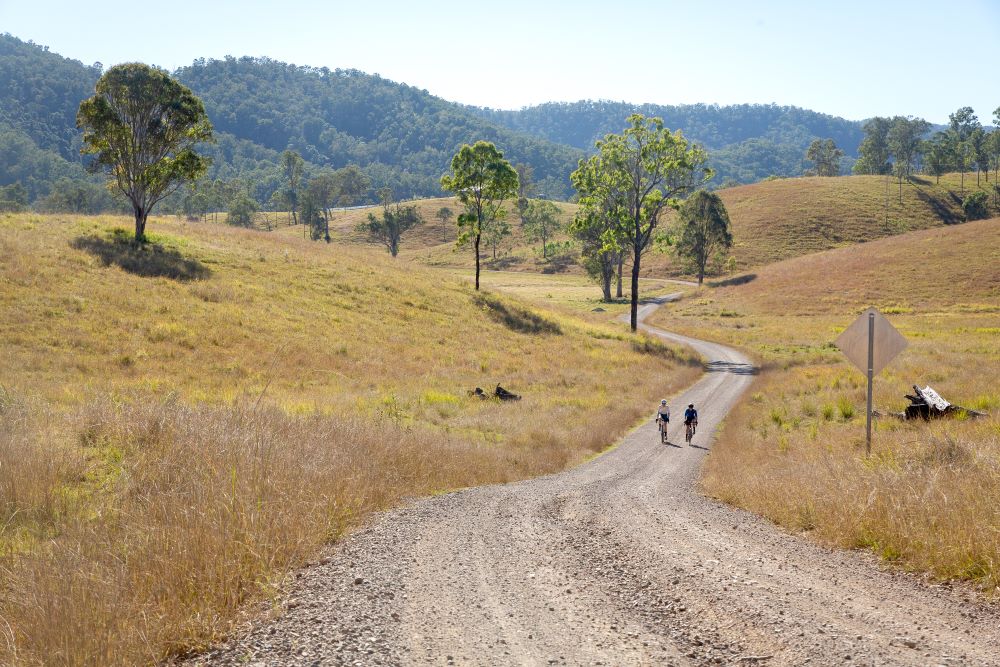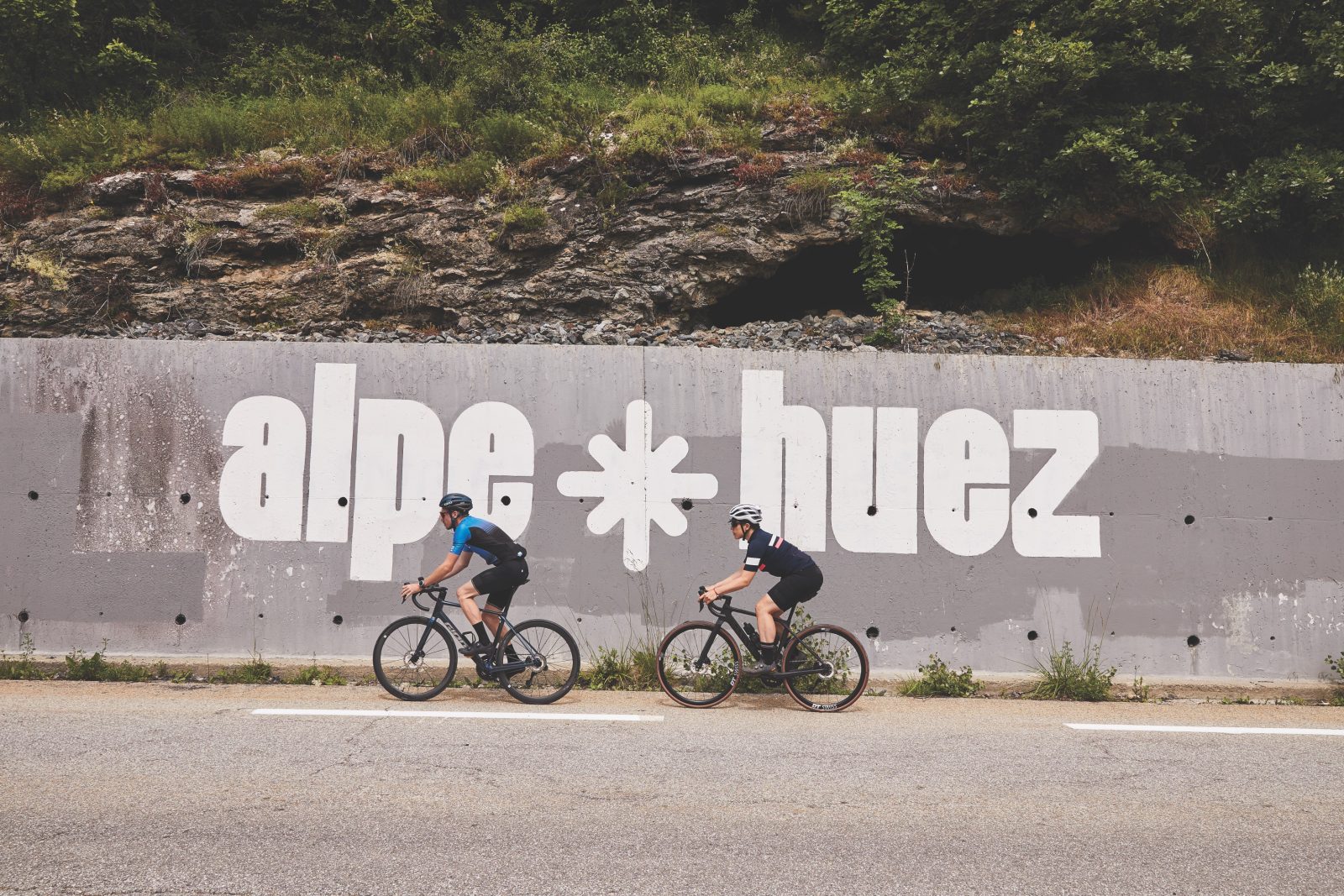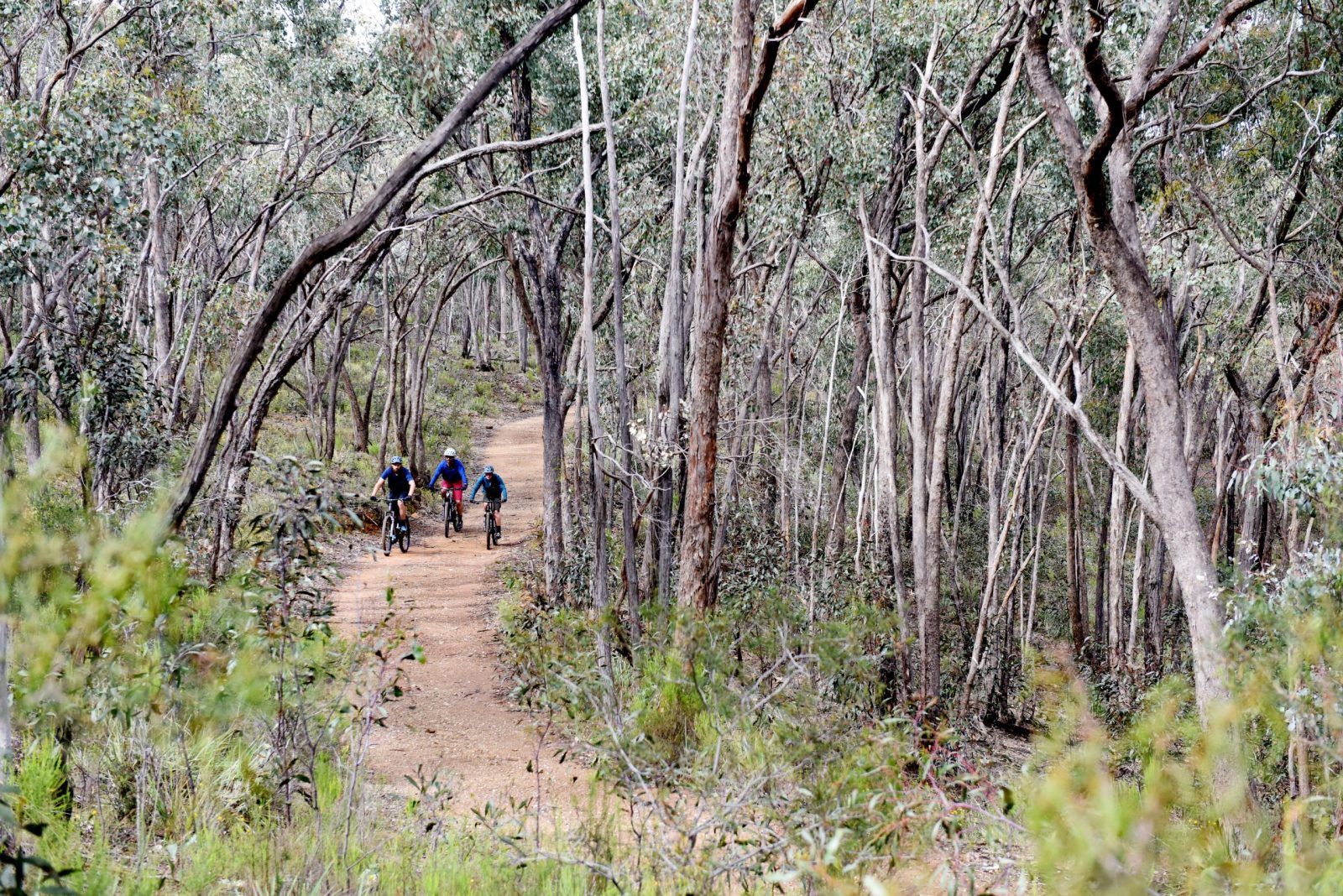Beloved by Queensland cyclists in the know, our Big Ride route for this issue is the same one used for the annual Sunday Creek Classic gravel endurance race: an epic 120km, 3,000m+ course starting and finishing in Kenilworth and highlighted by the notorious climb up Mount Buggery
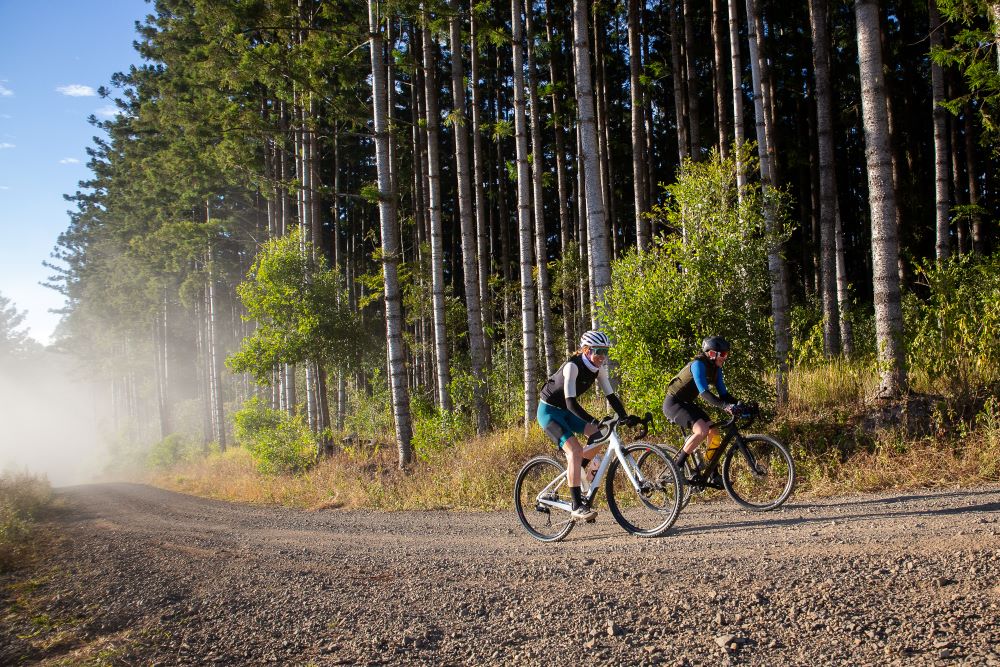
Words Imogen Smith Photography Mike Blewitt
A couple of hours north-west of Brisbane you’ll find Queensland’s golden triangle of gravel staked out between the towns of Kilcoy, Nanango and Kenilworth.
This is an area rich in vitamin G, embracing the 165km Brisbane Valley Rail Trail, national parks, proper-sized mountains, waterfalls, quaint towns and cattle stations – all of it traversed by hundreds of kilometres of finely brushed and gloriously deserted dirt roads.
Nestled in the Sunshine Coast hinterland, the old dairying town of Kenilworth succumbs weekly to massive inflows of tourists looking to park up at the famous bakery, while a non-stop supply of grey nomads make use of the excellent camping at the local showgrounds.
Once a year, the town gallantly withstands an odd armada of lycra-clad gravelistas who rock up at 6am, smash the public toilets, throw banana peels everywhere, then line up for the Sunday Creek Classic, a 120km tour of the blessed region’s most gruelling and rewarding backways, featuring, of course, the infamous climb over the equally infamous Mount Buggery.
Having competed twice in the Sunday Creek Classic, today was a chance to ride it ‘recreationally’ – which is to say, without grit shooting like shrapnel into your mouth, or feeling obliged to actually stay on your bike for the steepest ramps up Mount B.
No, today was a chance to take it all in at a leisurely pace, 4am start notwithstanding.
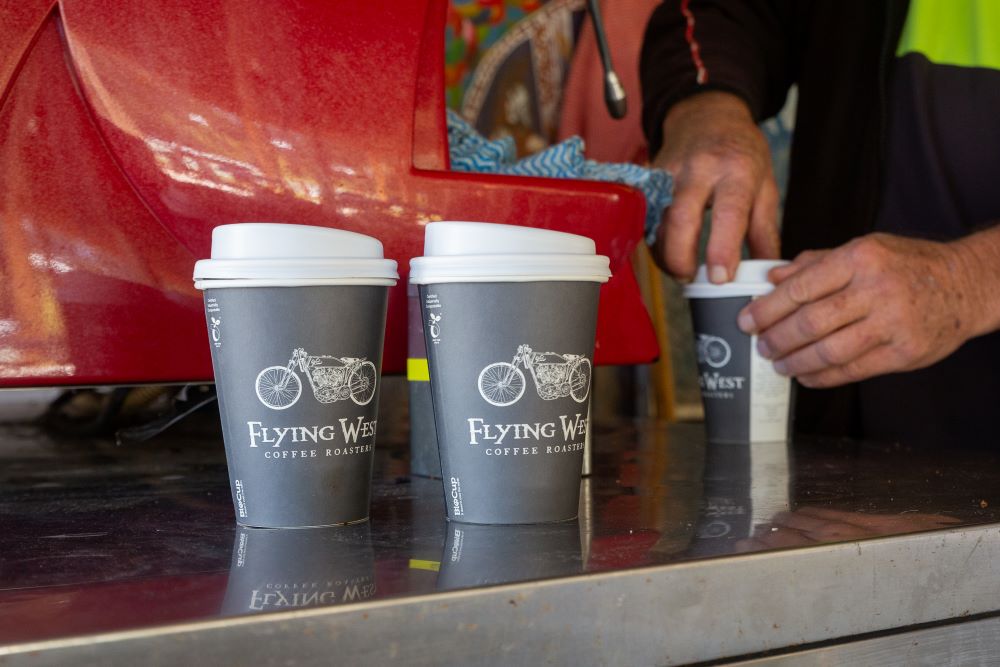
Cold call
Living in Brisbane, a ride in SEQ’s gravel heartland offers two options: make the trek up the Bruce Highway on Friday afternoon with every other weekender in the capital and camp or splash out on accommodation, or set the alarm for an excruciating hour and enjoy the dark and empty roads with a KeepCup balanced between your knees and the heating on full blast.
Photographer Mike and I chose the latter, taking off in the pitch dark, leaving our blue heeler alone to fill 13 hours with all the mischief a dog who’s 60% dingo and 40% sociopath could possibly devise.
As we drive through the night, waiting for dawn to break, we watch the lights on the dash count down the temperature from 10 degrees, to eight, seven, and finally six, as we carve amphibiously through cow pastures swimming in milky fog.
Rolling into town I reach for the volume and turn our beats down. Kenilworth is fast asleep.
The campground is silent, everyone hunkered down in their tents and vans, snoring away the early morning freeze like so many hibernating, greying, grizzlies.
Eve is there to meet us, Ugg boots swinging out the side of her camper.
It’s so [expletive] cold, she says. It’s [expletive] freezing, I reply.
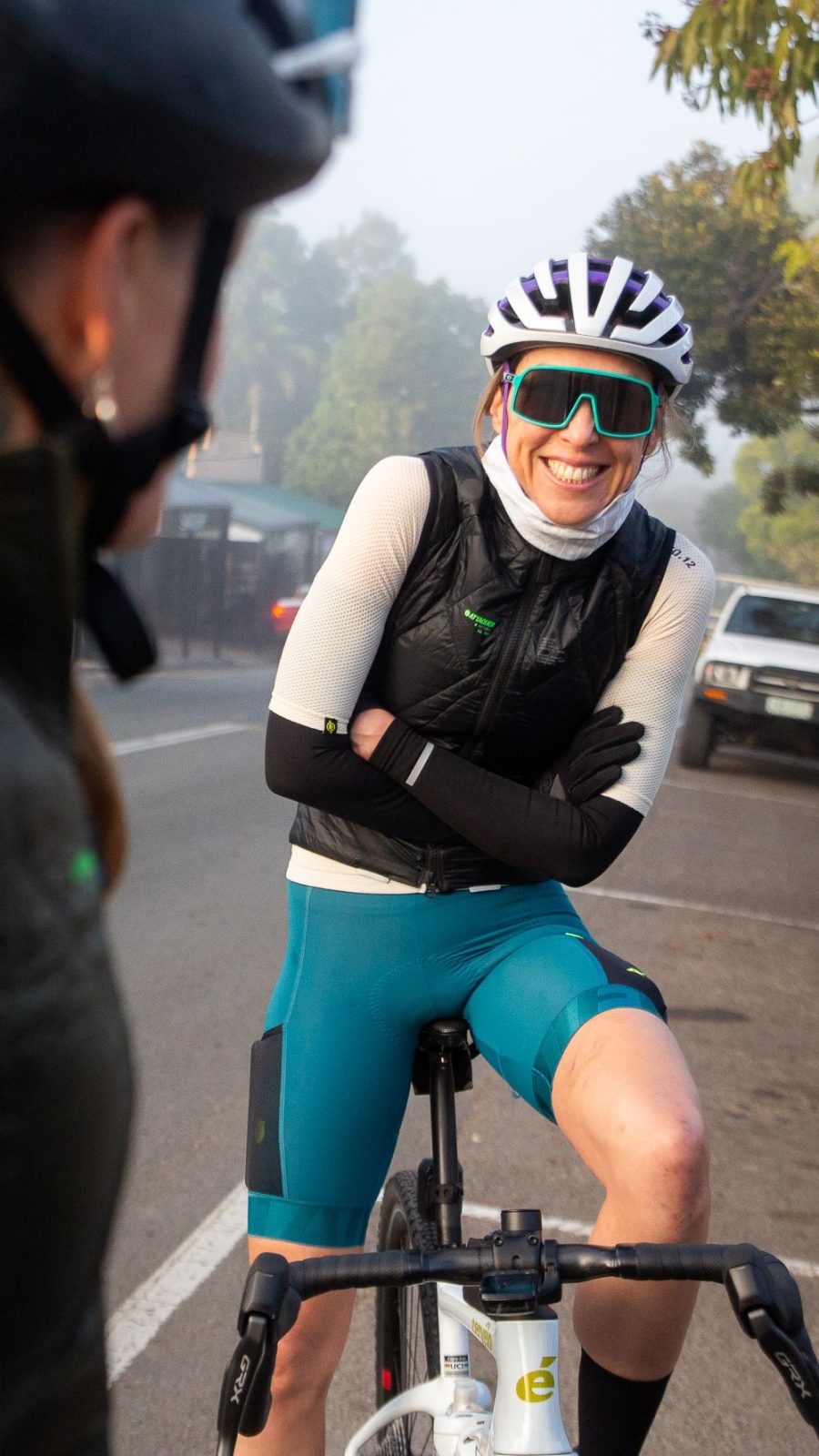
She has had a coffee, so there’s nothing to do but get out of my tracksuit pants (hard, with the steering wheel) into my new Attaquer kit (compression fit, also hard), bare my legs, grit my teeth and clip in, swinging onto the brief stretch of bitumen that leads us out of town. It’s four degrees.
We zip up and snuggle into Attaquer’s Anatomic Insulator vests, stuffed with special Swiss materials that completely block the cold, soupy fog.
By the time we reach the turnoff onto our first gravel sector just a few minutes later, blue sky – pierced by dizzying pinnacles of bunya pines – is already starting to appear, and the fog breaks up and swirls around eye-watering explosions of sunbeams that are the signature of pretty much every winter’s day in Queensland.
The gravel road takes us deep into the forest.
In early days Kenilworth, like most of Queensland’s hinterland, was stripped of precious timbers like red cedar and white beech to build the timber and tin houses of Brisbane and the hundreds of towns in the south-east.
In this case, a plantation of native hoop pine, dark and moody, has been planted in the rainforest’s stead.
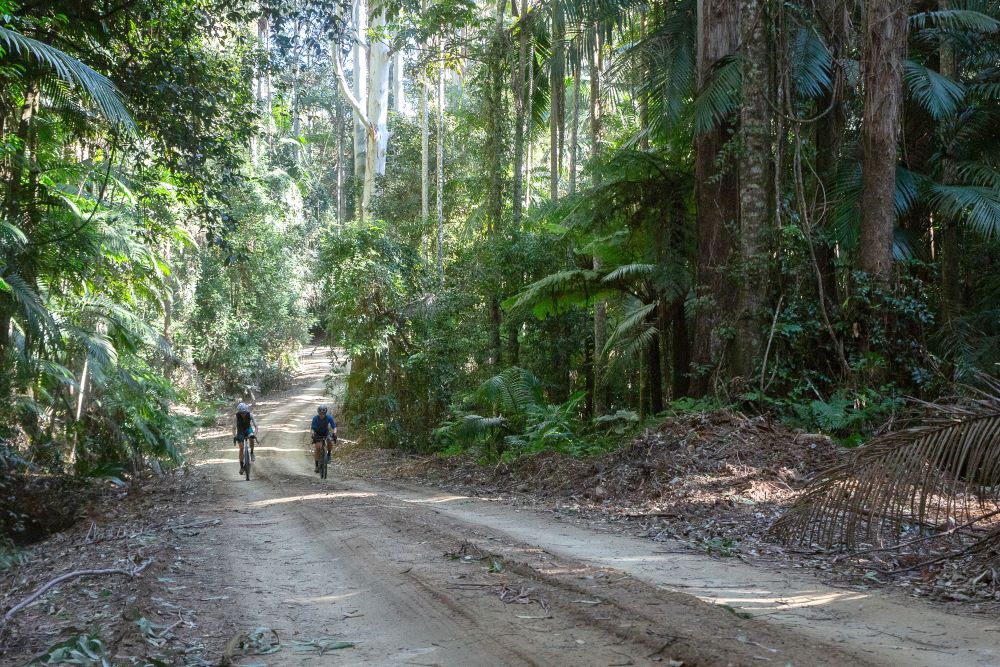
Mature and standing over 30 metres, the trees block out virtually all light, leaving us to once again hug into our puffy vests and push hard against climbs that come one after another like rollers on a wintry shore.
We dismount to tiptoe over some new construction work on a new causeway then before long emerge on kinder gravel roads that allow us to gain some speed and warm up, before a fast road section turns once again onto gravel roads through farmland surrounding Bella Creek.
Gone to Buggery
We cross Bella Creek several times, wending our way around huge cattle properties, where roos bound in among stampeding herds thundering beside the unfenced road.
Right on cue, at the 40km mark, we reach a fork in the road and, this being an adventure and the other fork being a dead end, we choose the branch heading straight up.
Mount Buggery, I’m later told, was surprisingly not named for its unforgiving gradients or its way-out-there location. No.
Boring as it may sound, the mountain is apparently named after the fellow who surveyed it – who went by the name of Buggery.
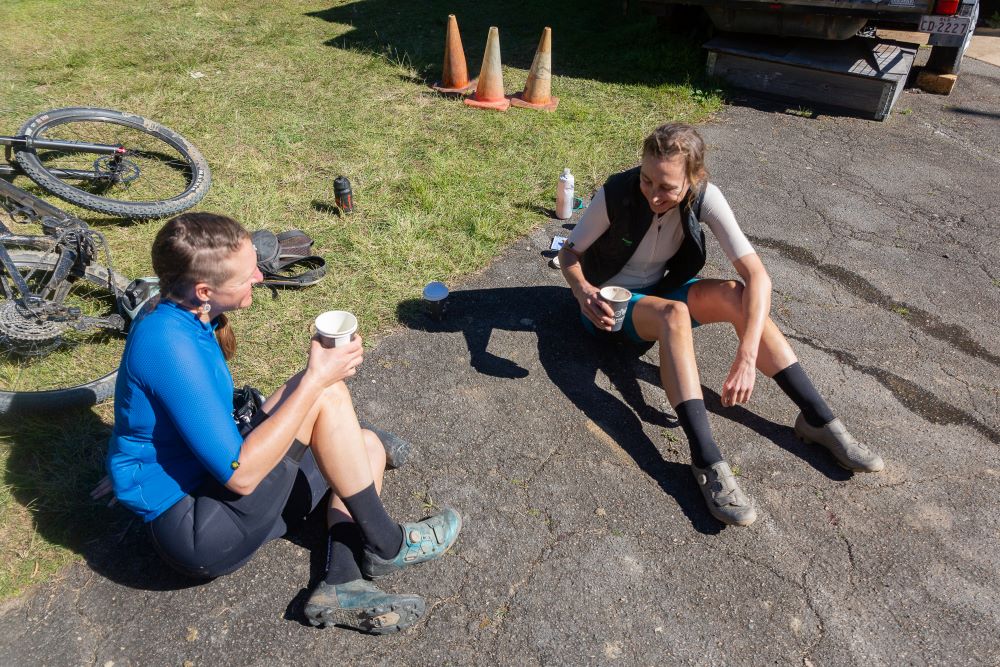
My searches of a bunch of national databases have failed to confirm or deny this, so I’ll just leave the folklore to stand. At 5.3km, and gaining nearly 500m elevation, Mount Buggery is the most notorious feature of this Big Ride.
It starts out manageably, with ramps of about 10 or 12%, lasting 100 metres or so.
Things get out of hand pretty quickly, though, with each ramp increasing the gradient until we give up and dismount.
I’ve ridden it on my mountain bike, but even my 12-speed Shimano GRX is no match for gradients that top out just a whisker under 30%.
That’s steep! Mercifully, the climb has recently been graded – in previous years it has featured vertical step ups and loose rock to add to the difficulty of riding it without a dab.
While Mount Buggery is the hardest part of today’s big ride, it’s also one of the most beautiful.
After about 4km of ramps we take our first stop to drink in views over rainforest valleys all the way down to Lake Borumba – but quickly, because a bunch of guys on touring motos are looking at us funny, and because we have nearly 80km still to go.
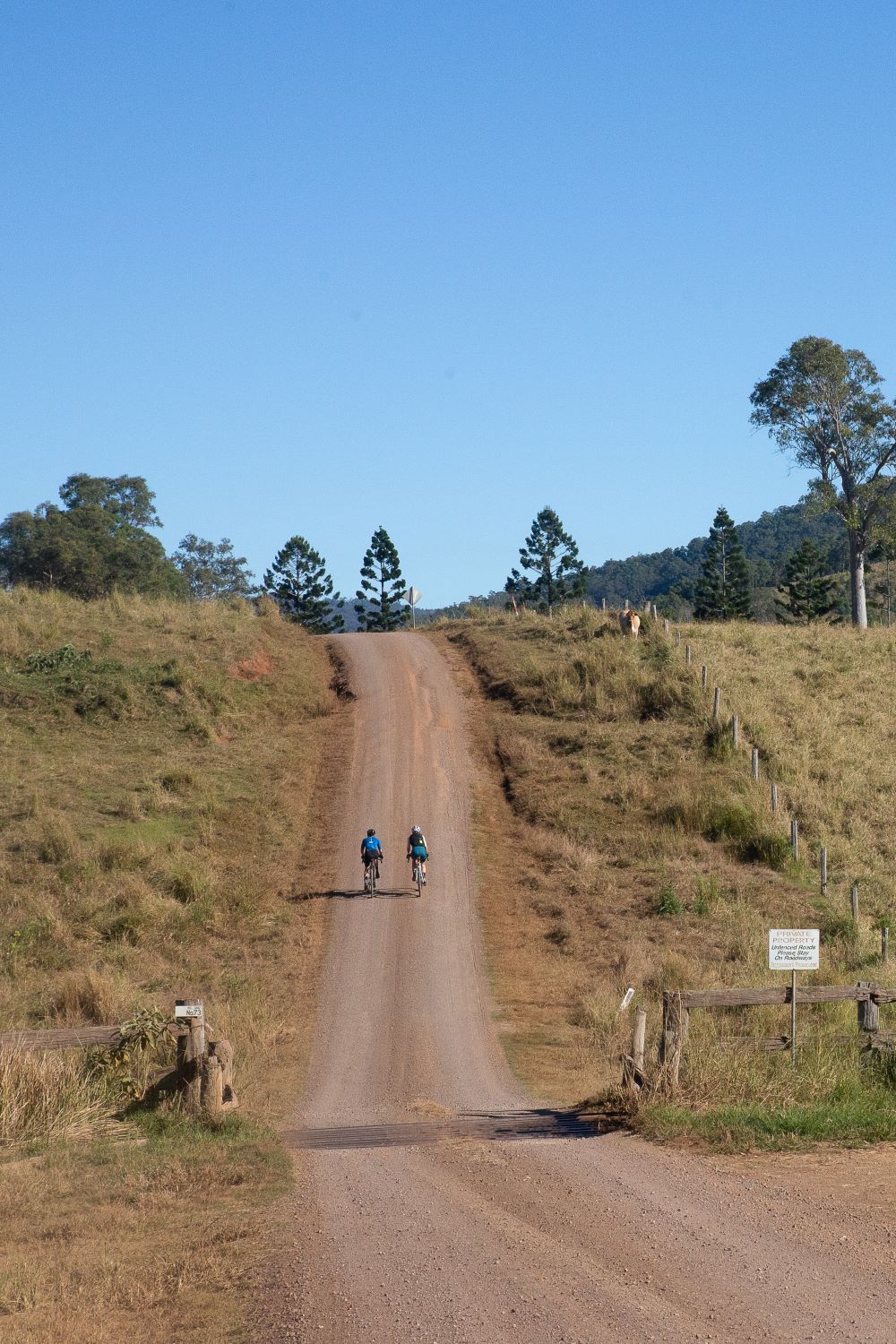
Jimna cricket!
The Sunday Creek loop can be divided into three sections.
First there’s getting to the top of Mount Buggery (tick), then there’s surviving the endless rolling gravel straights all the way to Jimna at about 74km.
Lastly, there’s the climb up Sunday Creek Road and the treacherous descent down the other side.
While it takes in some lovely gravel, the middle Jimna section can get a bit monotonous, and is best spent deep in conversation and deep in snacks, especially because the last few kilometres into ‘town’ get increasingly rutted and pockmarked.
With few smooth lines, and with the route’s one proper pit-stop just out of reach, it can feel inordinately hard to reach Jimna.
Jimna perches about 500 metres above sea level.
There’s just one bitumen road out, leading to Kilcoy, and a bunch of gravel routes besides.
The town has a small museum, about 70 residents, and the famous Jimna Base Camp, known to moto riders, bikers and four-wheel drivers as the place to stop for a snack, a coffee, or the night in the middle of any off-road adventure.

Jimna Base Camp is owned and run by Peter Cusack.
An experienced barista and cafe owner, Pete came to Jimna, like most of its inhabitants, looking for a treechange and a quiet life – and Jimna delivers.
As the Jimna Base Camp brochure says, Jimna has no fuel stops, no shops, no ATMs, ‘no anything’! Lucky for us, Jimna Base Camp does have what we need: sugar and caffeine in the form of excellent hot coffee, cookies, chocolate bars, coke, water and ice creams, as well as plenty of sunshine to park up in.
The annual Jimna Escape – a semi-organised gravel bikepack from Brisbane – stops overnight at the Base Camp’s campground, where there’s also a self-contained three-bedroom house for those who don’t want to carry all their bedding with them.
Before long we set off again, heading through a short section of singletrack before turning onto Sunday Creek Road for the last sector of our ride.
Under race conditions, this is a tough way to finish.
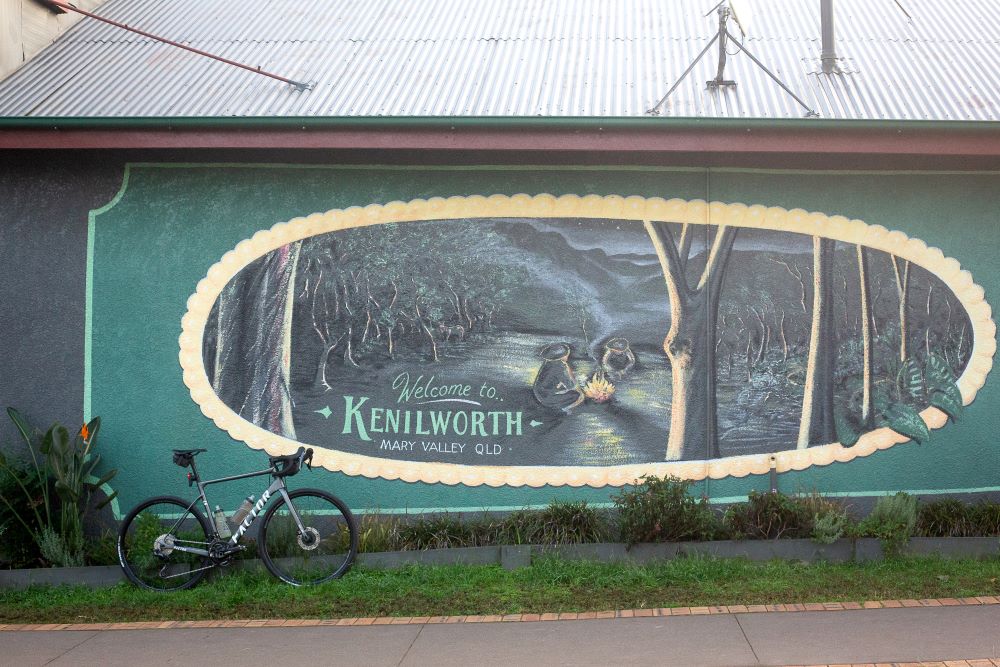
There are steep, rocky ramps and a never-ending ridgeline where, with nearly 3,000m of climbing already in the legs, every pinch creates pain and misery.
For us though, after a long stop and plenty of caffeine, the ride into denser and denser rainforest, with sun shooting through lattices of leaves and trunks, has us mesmerised, barely noticing the steady elevation gain.
The surface of Sunday Creek Road varies a lot depending on when the grader has been through – and while this time we’re lucky, we still manage three flats when we get competitive on the descents.
After Eve has thrown some tubes in, the mid-winter sun is hanging low, and we barely have the motivation to stop at the lookout to take in the views down towards the coast.
It’s time to finish the big descent and we’re impatient for some free speed.
After that we enjoy a fast run on flat, polished dirt road with the odd treacherous pothole all the way to the bitumen, where a short stint with postcard rural views takes us back to the showground, the epic bakery and, for a dollar, a four-minute, steaming-hot shower.
Then there’s nothing left to do but climb into the van and drive home to deal with the mess our heeler has made of the yard.
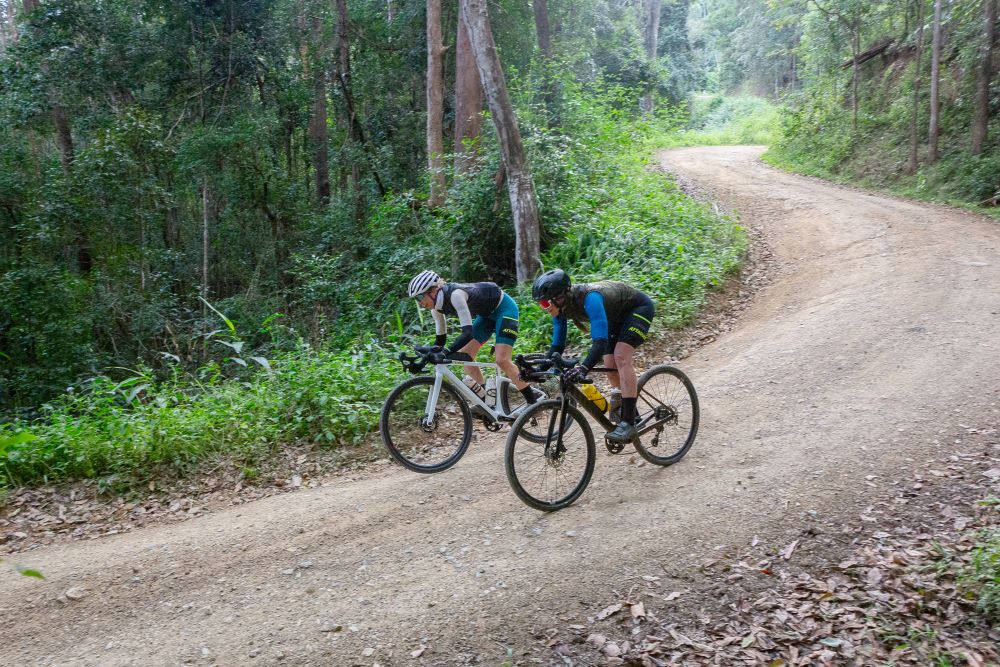
The route we took
Follow in Cyclist’s wheel tracks

To download this route, click here
We started at Kenilworth, parking next to the Showgrounds, then headed up the Kenilworth Brooloo Road, before taking to the dirt at Pullen Lane, leading into the Imbil State Forest.
Follow Coonoongibber Creek Road, Araucaria Creek Road and Derrier Road, which deliver you to the bitumen Yabba Creek Road.
After just a few kilometres, the turnoff to dirt at Bella Creek Road is still signposted with a Sunday Creek Classic sign at the time of writing, and from here the road to the bottom of Mount Buggery is easy to follow through the valley.
The road splits at the bottom of the climb, but stay on Bella Creek Road and keep going – the road becomes Mount Buggery Road, then becomes Kingham Road near the Kingham deer farm.
Keep an eye out for stags hiding in the long grass, or fawns playing near the homestead, and continue on undulating gravel roads until you reach the Kilcoy Murgon Road.
Be aware for 4WDs and motos as you find a smooth line among the holes and corduroy on the run into Jimna.
After Jimna, you can follow the GPX into a small section of singletrack, or continue on Kilcoy Murgon Road until the left-hand turn to Sunday Creek Road.
Sunday Creek Road will take you all the way over a massive climb and down the steep descent at about 100km in, before you join 4WDers and campers in the day use areas below.
There’s a final left-hander onto Kenilworth Rd and a smooth bitumen roll into town.
On weekends even the quietest gravel roads can be popular with 4WDers, moto tourers and dirt bikers, so always stick to the left and be smart on the descents.

The writer’s ride
Testing the new Shimano GRX Di2 12-speed

Not long before this ride I bought myself a brand new Cervélo Áspero and built it up with my favourite gear.
I wanted a fast and light gravel race bike, and the latest Áspero suits me – its tagline ‘Haul ass, not cargo’ sums up my personal gravel state of mind.
I’ve finished it with favourites like the new Favero MX-1 power pedals and a Tune Speedneedle saddle, but without a doubt, Shimano’s new 12-speed GRX Di2 was my most exciting upgrade.
I’ve used both XTR Di2 and Ultegra Di2 on other bikes and really like the zero-effort shifting and near total removal of any need to tune gears.
But the GRX 2×12 Di2 is quite different to both these 11-speed Di2 groupsets.
Like its current Di2 road groupsets, Shimano has introduced wireless shifters.
The GRX Di2 shifters are smaller in my hands than the mechanical 11-speed shifters, work better with flared bars, and can be aligned in a smooth inward curve with my gravel bars.
Shimano has also added an extra button on the hood – a little reminiscent of Flight Deck for those readers who rode bikes 20 years ago (I was in my early 20s and could only dream of affording such miracles of innovation!).
You can customise this via Shimano’s E-Tube app – I’ve got it set to change the screens on my Wahoo.
The 2×12 GRX Di2 allows for a wide gear range, with a 31/48 chainring setup paired to the Hyperglide Plus 11-34 cassette and chain.
I’ve used Shimano’s 12-speed equipment on my mountain bike for five years, and love how well the equipment shifts under load up and down the cassette. Nobody wants to shift under load, but on the dirt, everyone does.
This bike is the first time I’ve had Hyperglide Plus on drop bars. It makes a big difference.
Shifting on a gravel bike can be clunky. The jumps between chainrings aren’t small.
The terrain is rough, you’re often tired, and drop bars require a lot more muscle action to make a shift than MTB trigger shifters (this can be especially hard in the cold).
But with tiny motors in the zippy electronic derailleurs doing the heavy lifting, and the smart ramps on the rings, cassette and chain guiding the chain into place so quickly, this is hands down the best shifting I’ve ever had, especially under load.
By the numbers
Stats that matter

›29% max gradient of Mt Buggery
›4-24 Temperature range, in degrees
›9 Creek crossings ranging from bridges to causeways to full sends into rocky creek beds
›430 Grams of carb
›6:30 Moving time – at a leisurely pace
›2 Flats (and a puncture that sealed)
›0 Shops on route, but Jimna Base Camp is your mid-ride oasis with all the caffeine, sugar, facilities and info you could possibly need – open weekends or call ahead to check on weekdays
Ride the Classic
The Sunday Creek Classic, whose course we followed for this Big Ride, bills itself as a ‘very dirty gran fondo’ and is one of the most underrated annual events on the Australian cycling calendar – though it isn’t for the faint of heart.
‘Expect it to be tough,’ says race director Chris Dixon. ‘This event is for those who can race and complete a hardcore challenge.
There is minimal support during large sections of the event. You’ll be expected to be self-sufficient and carry your own water and nutrition for long sections of the course.’
If it sounds like your cup of tea, visit sundaycreekclassic.cc more information and, if you’re up for the challenge, go ahead and enter the next one, scheduled for 24 May 2025.
Surviving Sunday Creek Road
Top tyre setup tips
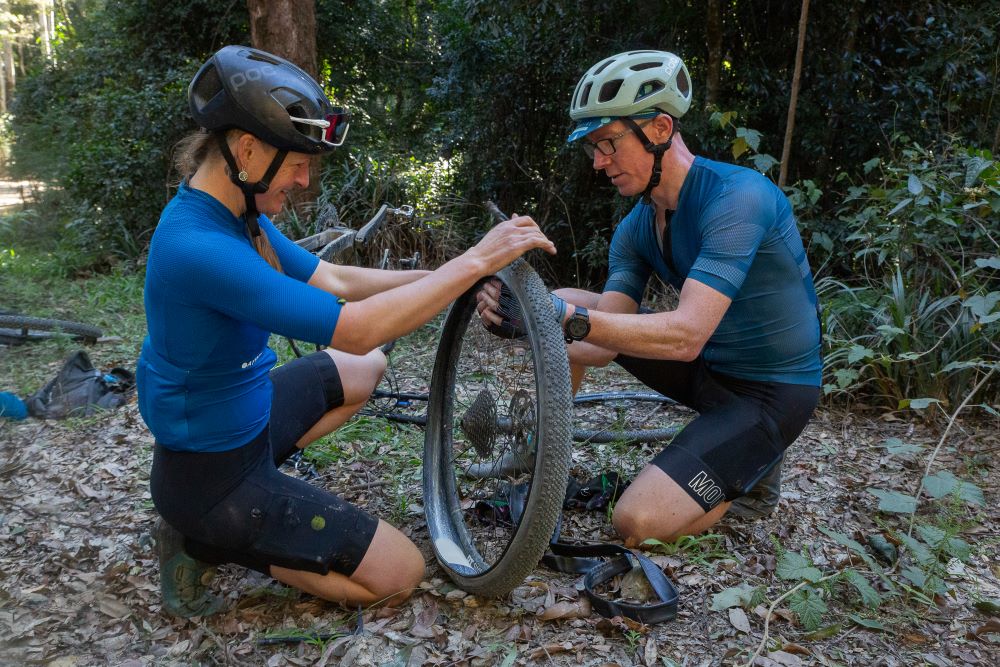
Sunday Creek Road has a reputation.
It traces a jagged ridgeline through the rainforest, and with high rainfall, it can be rutted, loose, and frankly, craggy.
The right lines and the right rubber keep you riding. Sending our bikes down Sunday Creek Road, my ride buddy double flatted, needing tubes in both wheels… and new tyres the next morning.
I hit a sniper rock, piercing my tyre, but it sealed instantly.
The Sunday Creek Classic race is often shaped by people getting flats – and the same can be said of many gravel races.
Setting up the right wheel system with a strong tyre, inserts, fresh sealant and plugs really makes a difference.
I used Maxxis Ravager 40mm tyres on 25mm rims, set up, as always, tubeless.
I also use a tyre insert, which really makes a lot of sense for gravel, as you can run lower pressures for comfort and grip, while the foam insert protects rims from damage, stops the tyre rolling off and helps prevent cut tyres from impacts.
I carry a Dynaplug kit for any small punctures that sealant won’t fix – the little tool places a little stick plug in the hole and makes the job easier for your tubeless sealant.
And here’s a tip: think of your sealant like milk.
You wouldn’t continually top up your milk in the fridge, right? Sealant needs to be fresh to be effective.
How we did it

Travel
We chose to do the roughly two-hour drive from Brisbane at an ungodly hour, but there are many ways to get to SEQ’s gravel nirvana.
For those coming from interstate, Sunshine Coast Airport is the closest option, and Brisbane Airport has plenty of flights and is situated on the north side of the city, just 1hr 40mins’ drive from Kenilworth.
Accommodation, food and leisure
For campers, Kenilworth Showground has excellent facilities and is popular with grey nomads. There are also a small number of cabins and short-term rentals in the immediate area.
Kenilworth has a nice pub and several tasty food choices for an evening meal, and for snacks nothing beats the historic bakery, so popular it’s divided into two separate stores – one for sweet treats and one for savoury (check out the old oven on the savoury side).
Travelling with non-biking companions? There are national parks, waterfalls, farm gates and several parks and small museums dotted around the area.
The popular hinterland towns of Maleny, Montville and Mapleton make for short scenic drives from Kenilworth, and Noosa is about 50mins away.
Kilcoy is close by and has more food options, shops, and a couple of budget-friendly motels as well.
If you want to explore the broader area, Linville is a great option.
While further away from this ride’s start, it’s a great launchpad to endless gravel adventure and has camping and some amazing overnight options, including bespoke bike accommodation.
Thanks
A massive thanks to Sydney-based clothing outfitter Attaquer for kitting us out in fresh All Day threads, as well as the incredible Anatomic Insulator vests, and to Pete Cusack from Jimna Basecamp for the maps, coffees and local lore.
